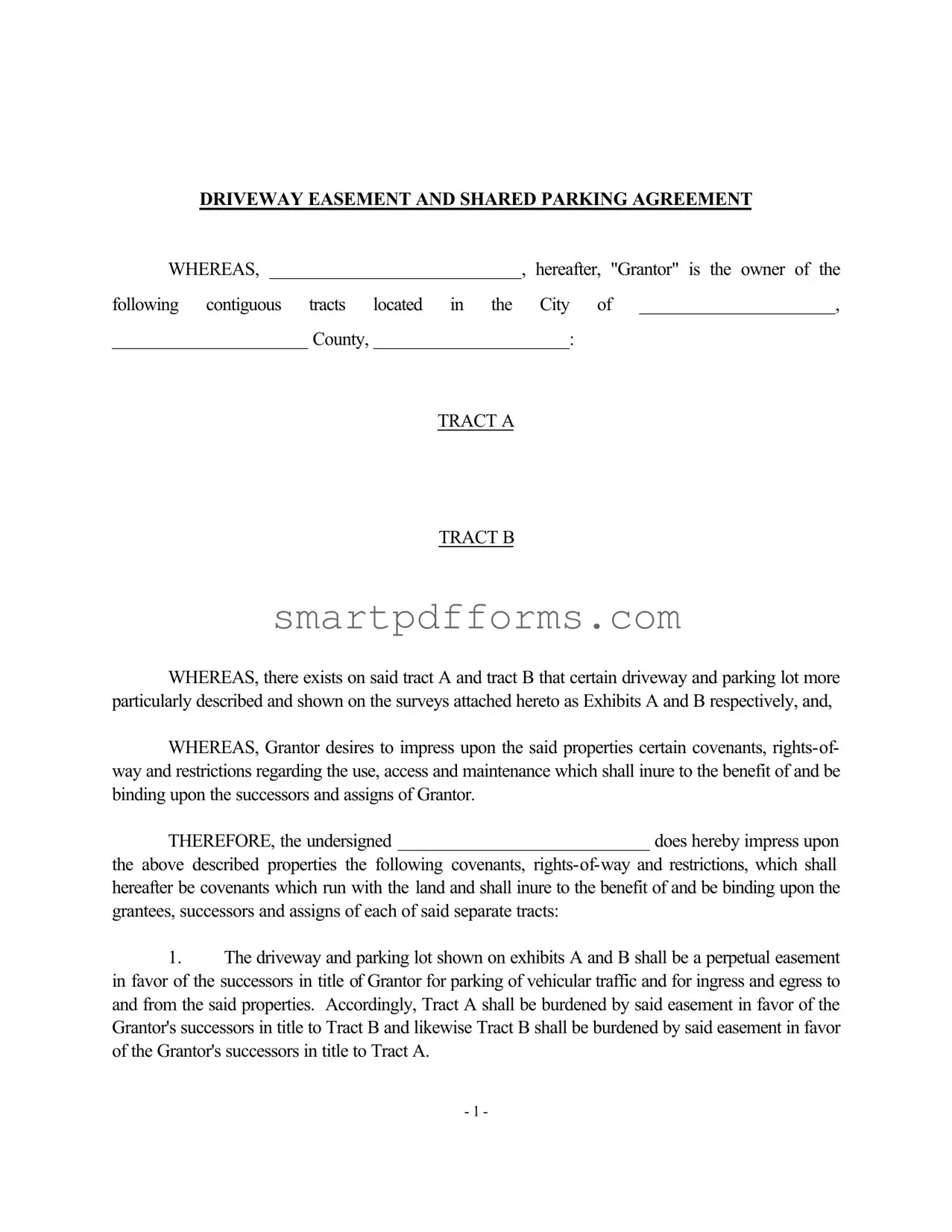DRIVEWAY EASEMENT AND SHARED PARKING AGREEMENT
WHEREAS, ___________________________, hereafter, "Grantor" is the owner of the
following contiguous tracts located in the City of _____________________,
_____________________ County, _____________________:
TRACT A
TRACT B
WHEREAS, there exists on said tract A and tract B that certain driveway and parking lot more particularly described and shown on the surveys attached hereto as Exhibits A and B respectively, and,
WHEREAS, Grantor desires to impress upon the said properties certain covenants, rights-of- way and restrictions regarding the use, access and maintenance which shall inure to the benefit of and be binding upon the successors and assigns of Grantor.
THEREFORE, the undersigned ___________________________ does hereby impress upon
the above described properties the following covenants, rights-of-way and restrictions, which shall hereafter be covenants which run with the land and shall inure to the benefit of and be binding upon the grantees, successors and assigns of each of said separate tracts:
1.The driveway and parking lot shown on exhibits A and B shall be a perpetual easement in favor of the successors in title of Grantor for parking of vehicular traffic and for ingress and egress to and from the said properties. Accordingly, Tract A shall be burdened by said easement in favor of the Grantor's successors in title to Tract B and likewise Tract B shall be burdened by said easement in favor of the Grantor's successors in title to Tract A.

2.The successors in title to each tract shall not obstruct or restrict the use of any portion of the said parking lot and driveway and no buildings or improvements may be erected upon said easement.
3.The easement shall be maintained in a serviceable, neat and acceptable manner and in a manner so that the overall appearance of said driveway and parking lot shall be uniform. Each of Grantor's successors in title to Tracts A and B shall be charged with the repair and maintenance thereof and shall cooperate with each other in the performance of routine and necessary repairs, overlay and sealing of the said driveway and parking lot. The successor in title to either tract may perform such repairs and maintenance as may be necessary without the consent of the other upon giving written notice of intent to perform such repairs and the estimated cost thereof. Notice may be delivered by U.S. Mail, certified, return receipt requested or other personal service not less than thirty (30) days prior to beginning such repairs or maintenance. The party that performs said repairs/maintenance shall be entitled to a lien upon the property of the dissenting party equal to one-half of the actual cost of said repairs/maintenance plus fifteen per cent (15%). Said lienholder shall have the same remedies as holders of materialmen in accordance with the Materialmen Lien laws of the State of
___________________________.
4.In the event it becomes necessary to enforce the terms of this easement through court proceedings the prevailing party shall be entitled to reasonable attorneys fees.
Witness the due execution hereof on this the ____ day of _________________, 20____.
By:
GRANTOR
STATE OF
COUNTY OF
Personally appeared before me, the undersigned authority in and for the said County and State, on this day of , 20 , within my jurisdiction, the within named , Grantor, who acknowledged that he executed, signed and delivered the above and foregoing instrument on the date there provided.
NOTARY PUBLIC
My Commission Expires:
- 3 -


